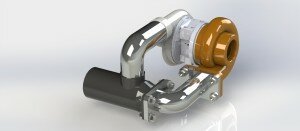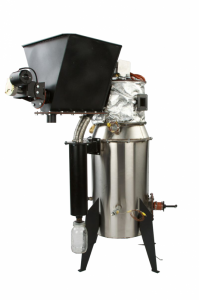Because we are convinced that biomass is an important part of a renewable energy mix, we were looking for a small scale, decentralized power generation system for people who life off the grid or want to net meter back to the grid. Decentralized facilities have a lower carbon footprint for harvesting and transportation of biomass fuel, compared to the large scale centralized facilities.
With rapidly rising costs for hydro, it also could be a lucrative sideline for farmers or light industrial businesses. It is the most competitive renewable energy you can get compared to PV, Wind or other renewable energy sources.
With this all in mind, we decided to installed a Biomass Power Generation facility on our location in Smithers BC.
Specifications
-
Fuel Capacity – 5200 cubic inches in hopper – 1500 cubic inches in auger feed hopper
-
Gas Composition – (varies) 50% N2, 22% CO, 18% H2, 8% CO2, 2% CH4
-
Run Times – 8 to 12 hours, optional automated hopper feed possible
-
Kilowatt Outputt – 10 to 30 KWe
-
Tars/Particulates – less then 10ppm with quality feedstock
-
Fuel Types – pellets, wood chunks, thick chips
-
Genset – 30KW 2.3L modified Ford 4 cyl. LP/Natural Gas
Introduction
Producer gas is formed by the partial oxidation at elevated temperature of a carbonaceous feedstock such as biomass or coal in a suitable furnace, generator, or producer unit; hence the name producer gas. The process is known as gasification and is a relatively old technology that was used extensively throughout Western Europe to produce ‘Town’ gas from coal before natural gas became widely available. During the Second World War many vehicles towed wood gasifiers as their fuel supply.
More recently there has been a resurgence of interest in biomass gasification for the production of fuel for power generation.
Partial oxidation, or gasification, takes place when there isn’t enough oxygen present for full oxidation to occur i.e. when less than the stoichiometric amounts of oxygen needed for complete combustion are present. As a result of this, partially oxidised products are formed.
If the temperature is sufficient, the primary products from the gasification of biomass are gases:
* carbon monoxide (CO)
* carbon dioxide (CO2)
* hydrogen
* methane
* trace amounts of higher hydrocarbons such as ethane and ethene
* water
* nitrogen (if air is used as the oxidising agent)
Various contaminants such as small char particles, ash, tars and oils are also present with the gases. If the temperature or contact time is insufficient, there will be an undesirably high level of carbon dioxide (CO2). If the fuel is damp there will be hydrogen present and a little water or steam may be injected to raise the calorific value of the gas and reduce the proportion of nitrogen dilutant. Excessive amounts of hydrogen or moisture are a disadvantage, and as metering is difficult, this provision may be omitted.
Typically producer gas has a low calorific (energy) value of 4-12 MJ/m3. This is due to the dilution of the product gases with nitrogen from air during the gasification process. In addition to its low calorific value producer gas is difficult to liquefy or compress and small-scale gasifiers, in particular, can be difficult to control to match variations in load. Therefore producer gas is best suited for use in stationary (i.e. power generation) rather than automotive (i.e. mobile) applications. For power generation applications it is usual to use producer gas to fuel internal combustion (IC) engines to drive a generator although on large-scale plants (>5MW) gas turbines can be used.
At high temperatures, charcoal and liquids are either minor products or not present in the product mixture. The partial oxidation can be carried out using air, oxygen, steam or a mixture of these. There are three basic gasification techniques: air gasification, oxygen gasification and pyrolitic gasification.
Air gasification, although producing gas with the lowest calorific value (typically 4.2 MJ/m3), is a much more widely used technology than other gasification techniques. This is because oxygen production and usage incurs an extra cost and hazard and also involves the complexity of having multiple reactors.
A producer gas unit consists of a number of components:
Gasifier
The gasifier is usually cylindrical in shape for strength and ease of manufacture. Fuel is fed by gravity from the upper hopper section into the lower fire zone section. There are three basic kinds of generator, named from the airflow direction. Down-draught units have a
restriction around the hearth causing an increase in air velocity and higher operating temperature which tends to gasify tars which would otherwise be a problem when using green wood as fuel. Updraught gasifiers are efficient producers of industrial type heating gas where higher tar contents are no problem.
Cross-draught gasifiers have a small intensely hot fire zone with air fed from a nozzle or tuyere. The refuelling lid and ash removal door must be air tight, and gas is sucked out by the engine through a lateral delivery pipe. With a restricted fire zone, it is not necessary to protect the casing with refractory or stainless steel lining, but it is essential to use evenly sized well packed fuel if gasification is to be efficient. A fourth type is a combination of the above.
Cleaning section
On leaving the gasifier, producer gas must be cleaned of impurities such as soot, ash, unburnt fuel dust and tar in order to prevent engine damage. The design and sequence of components will depend upon requirements of fuel and engine, but must not offer excessive resistance to the gas flow if engine starvation is to be avoided.
Primary removal of coarse material may be effected by a simple expansion box, a baffle box or a cyclone, in which particles drop out of the gas stream when the gas changes direction and loses velocity.
Secondary cleaning, which may follow the cooling section, may be a dry or wet process. The gas may be filtered dry through sisal, wood, wool, felt, paper, fabric, or close-set brush bristles, and electrostatic filters are also on the market. In wet filtration, the filter element is wetted with oil (usually diesel or kerosene) or water. Water is not very effective against tar but may reduce the incidence of explosions. Wet filtering is also called scrubbing or washing.
The choice of filters should not be made on technical efficiency alone but rather on possible operational reliability. Experience with agricultural tractors has indicated that for example, although modern paper air filter elements may be capable of high efficiency, the odd hole may cause serious and costly breakdowns in equipment and operations under practical third world conditions.
Cooling section
Cooling the gas will increase its density, so allowing a greater charge (by mass) per cylinder, and exposed piping when cooled will become less of a fire hazard. After the primary cleaning unit, the gas may then be passed through a radiator unit mounted at the front of the engine.
The cooler may be by-passed by means of butterfly valve for starting from cold if condensation is found to clog dry filters. A fine wire gauze or felt cloth placed before the engine as a “security filter” will clog up and provide warning of failure of the cleaning-cooling sections when the engine stalls.
Mixing valve
Efficient engine operation requires adequate adjustment of the proportion of air and gas, and the quantity of the resulting mixture reaching the engine. In its simplest form the valve consists of a Y-piece. The gas enters through one branch, the air from an air cleaner through the second branch, and the resulting mixture flows through the stem to the existing engine induction system between the carburettor and the induction manifold. The admission of air is controlled by a butterfly valve in the air branch.
Some design refinements
While the preference would be to use purpose designed gas engines it is possible to use producer gas as a fuel for either spark ignition (SI) and compression ignition (CI) engines. However, as producer gas cannot easily be liquefied it has to be introduced by means of a gas carburettor and is present during the compression stroke for both types of engine. In the SI engine the gas is ignited (as for petrol) by a high voltage spark but in the CI engine ignition is achieved by injecting a small amount of diesel into the cylinder at the end of the compression stroke. Modern gas engines are available which are similar in design to CI engines (for strength and durability) but use a spark plug or glow plug to provide ignition for the gas
Spark ignition engines are cheap, if based on mass-produced automotive engines, and are simple to operate but are sensitive to changes in gas quality. Little modification is required to an automotive engine other than changing the carburettor for one suitable for use with gas and hardening the valves and valve seats. These engines can be operated on 100% producer gas achieving efficiencies of around 25% at full load but this can fall off rapidly when operating at part loads.
Consideration also needs to be given to the ignition timing of the engine. Typically there is a greater ignition delay with producer gas compared with petrol. Therefore the ignition point (the crank angle at which the spark occurs) of a SI engine is usually advanced when a gaseous fuel is used to ensure optimum performance.
The CI engine is much more complex to operate and will not work on biogas or producer gas alone. If biogas were admitted in anything like the stoichiometric ratio, it could spontaneously ignite during the compression stroke. The engine would then ‘knock’, run unevenly, and overheat very quickly. Therefore the gas can only be admitted to the engine at quite high air/fuel ratios grater than 30:1 (by mass). The exact ratio will be dependant on the design of the engine and its compression ratio.
Most large, medium and low speed engines normally operate as diesel engines with an air/fuel ratio of around 30:1 and so it is possible to operate them on 90% gas and 10% diesel especially if they have relatively low compression rations of around 14:1. Smaller, high speed CI engines (auto derivative) are normally rated with relatively low air/fuel ratios of 20:1 and compression ratios of between 16 and 18:1. These engines require much more diesel fuel injected at maximum load some times as much as 60%. Compression ignition engines can operate on all ratios of producer gas/diesel oil, which can be desirable when producer gas production is subject to fluctuations.
Compression ignition engines are more expensive but are less sensitive to changes in gas quality and have better efficiencies (30 and 35%), which can be maintained through out regardless of load.
Spark and compression ignition engines will require modifications to the valves, valve seats and carburettor before they can be used with producer gas. The dry nature of producer gas means that it does not have lubricating properties and therefore valve wear is more likely to occur. The materials used for the valves and valve seats will need to be modified (i.e. hardened) or changed to improve wear resistance.
CI engines also require several other major modifications. These include lower compression ratios, provision of extra cooling to injectors, and the fitting of gas carburettor.
Generally spark ignition engines are less robust than compression ignition engines but don’t need supplementary fuel. Therefore it is common to convert compression ignition engines to spark ignition as a compromise between robust and reliable operation and to alleviate the need for supplementary fuels.
Loss of engine performance
When using producer gas, power loss may occur in four ways:
1 The presence of nitrogen from the atmosphere as an inert dilutant of the gas-air mixture will cause a reduction in power of about 35 to 50%.
2 The power required to carry the additional load of the gas unit, of between about 200-700 kg for units to operate engines up to 3-litre capacity.
3 The normal derating or unblown engines due to increasing altitude and ambient temperatures round in many low income countries.
4 Due to the above, a modern engine designed for use with high grade fuels, may no longer be able to operate on the centre of its power curve, resulting in loss of performance.
Maintenance
A producer gas unit must be refuelled before the fuel level has dropped more than about three quarters, or to keep at least 300 mm of fuel above the fire zone, or the production of gas will be interfered with and the possibility of explosions increases.
Maintenance will include refuelling, the removal of ash and any clinker from the generator, and the removal of dust and condensates from the cleaning and cooling sections. Normal lubrication should be unaffected. Engine wear may be reduced with an efficient gas unit due to there being less corrosives, a lower exhaust gas temperature, less carbon deposited, and less bearing wear due to a smoother slower rate of burning. It is important that no leaks are left unrepaired, so regular frequent inspections are essential in order to maintain the unit in an efficient and safe condition. This may not be done unless arranged through a central garage service.
Fuel
Any carbonaceous material can be converted to producer gas but automotive use requires a reliable source of high quality gas, low in dust, moisture, tar and sulphur. The fuel must be evenly graded, of moderate particle size, with a high reaction response, high calorific value, and having low ash and clinker characteristics. The fuel should be cheap, readily available and uncontaminated by soil and water.
Good quality wood-chip ranging from 20mm to 75mm with moisture content of up to 20% is best suited for gasification. Fine grained material such as sawdust would be as good if briquetted, but this process is difficult and expensive in practice, especially as the end product must be low in tar, moisture and clinker, a situation aggravated by most binders.
Good quality hardwood charcoal also makes an idea fuel for gasification. Good charcoal has a low tar content compared to many other biomass materials which may be advantageous as tar can be difficult and expensive to remove from producer gas. The best charcoal, evenly burnt and free of contamination, is produced in a retort. Charcoal from a pit may contain soil and unburned pieces high in tar.
To change seasonally from one kind of fuel to another could involve major modifications to equipment if this involves a change in fuel characteristics.
Fuel consumption
Figures quoted by different sources vary considerably due to variations in fuel, in gas and in operating conditions. Good quality producer gas may have a calorific value (CV) of about 4,200 kJ/m3 at normal temperature and pressure (NTP). The problem is that while a high
contact temperature is required in the fire zone of the gas generator for efficient gasification; a low air-gas temperature is required for efficient engine operation (volumetric efficiency). Calculated on a cold gas basis at NTP, producer gas has an efficiency of about 72%.
Efficiency = potential heat in qas/total heat in fuel
However, this may be reduced in practice by the incorrect proportion of air admitted, and by temperatures which in practice will be higher than ‘normal’ (NTP), hence the importance of temperature control in gas units.
1 kg air-dry wood (15 -20% mc) produces approximately 2.3m3 gas
1 litre petrol = approximately 2.5 to 3 kg wood
1 litre diesel = approximately 3 to 3.5 kg wood
1 kWh requires approximately 1.0 to 1.3 kg charcoal, 2 to 4 kg wood chip (depending on moisture content), or 2.4 to 3.2 kg rice husk
Project implementation
While the gasification of biomass materials is technically practicable other criteria will also have to be considered when deciding to implement a gasification project. This included gasifier application (i.e. small-scale off-grid electricity production, large scale centralised generation etc), the availability of appropriate equipment, availability of a suitable and reliable fuel source, regulations (local and national), operator availability and cost and financing.
Determining the economic feasibility of a gasifier project requires realistic site-specific estimates of capital, feedstock, labour and maintenance costs as well as the value of the electricity and heat produced.
The following factor should be considered:
* the cost of the fuel
* the cost of the gasifier and ancillary equipment
* the cost of money at prevailing interest rates
* the cost of operating labour
* maintenance and replacement costs
* design life of the equipment
* value of the power produced
* value of the heat produced
* cost of disposal of the residual materials (ash, tar etc)
* retail cost of electricity and heat
* benefits of using renewable energy (i.e. using locally available fuels, reduced reliance on imported fossil fuels, local ownership and control of the technology etc).
Any manufacturing programme would need to consider patent rights, the risk of litigation, manufacturing rights, and the need for a national programme as part of a total energy policy, backed by media propaganda and any necessary alteration in legislation to legalise modified vehicles that might otherwise become illegal or penalised.
Other possible side effects of an introduction of a new fuel system might include reduction of pollution, a cut in government revenue from liquid fuel tax, the diversion of low value biomass material to an alternative new and possibly lucrative market, resulting in the possible impoverishment of soil, crop failure and increased poverty amongst the low income sector of the community least able to withstand change, so converting what might appear to be a technical solution to power generation into a social disaster.



